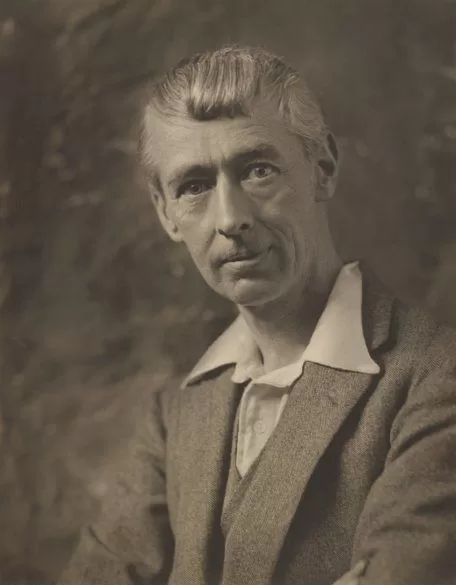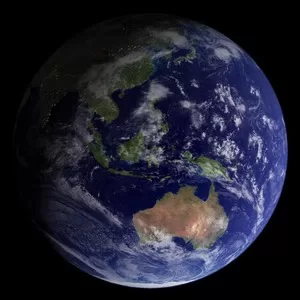It wasn’t simple wanderlust that brought the extraordinary Australian artist Norman Lindsay (1879-1969) to American shores. He was fleeing the “mob imbecility” and the outraged “wowsers” when he stepped aboard the Aorangi, which left Sydney on July 23, 1931.
He feared that they wanted him imprisoned upon seeing the nudity in the just published Special Norman Lindsay Number of Art in Australia (December 1930.)
In a letter to Leslie Meller from June 1931, Lindsay noted that the editors of Art in Australia had “been hauled before a police court,” and he was “expecting any moment a police raid on my home.”
In fact, he was so worried about possibly being brought up on obscenity charges, as Jane Lindsay recalls in her illuminating Portrait of Pa, that he cut up two great large oils that hung in his drawing room of Witches’ Sabbaths, that featured naked witches and demons tumbling through the sky.
Coming on the heels of his novel Redheap having just been banned the previous year, he felt he had no choice but to leave “the best country in the world, were it not for the wowsers.”
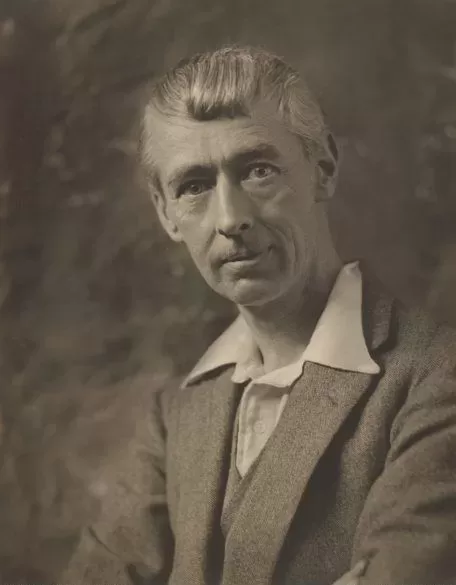

So picture a slender man (he considered eating a waste of time), medium height, thin brown hair combed forward, well dressed, probably wearing a hat, animated, accompanied by his wife Rose, stepping off the ocean liner into America’s welcoming arms.
After all, he was no stranger to the United States.
Already well known for many years in his native country for his work in the Sydney Bulletin and The Lone Hand, his debut performance here was in Harper’s Weekly, and had consisted of back to back appearances at Christmas time—the time of year when magazine publishers usually make a special effort to include more art and fiction in celebration of the holiday.
Harper’s Weekly, the first issue of which was published January 3, 1857, along with periodicals like Century and Scribner’s, had become established in middle and upper class households as the cultured reading of the day.
Although not yet his mature work, his illustrations in the December 10, 1910 issue of Harper’s are immediately recognizable as from his hand, and stood out against a background of the other impressive artwork found in this magazine.
The other artists appearing ranged from Peter Newell to Anton Otto Fischer, from Paul Stahr to John Newton Howitt, all of whom would later become well known and respected. Lindsay’s four pen and inks and one pencil drawing were reproduced as a full page treatment for “Homeward Bound,” rousing, seafaring verse enhanced by his typically full of life depictions of sailors at work on board ship, and chasing ladies on shore leave.


Norman Lindsay ° The Girls of Spain, Harper’s, 1911 ° The Bulletin, 1917
In the Christmas 1911 issue his work, again presented full page, were three fine drawings accompanying a Richard Le Gallienne poem “The Girls of Spain.”
His mastery of black and white illustration is not only evident in these two humble journalistic commissions, but very original as well.
Although one can see the influence of his acknowledged early inspirations, being Dore, Sandys, Abbey, Vierge, and others, (and later on Heinrich Kley), these illustrations for Harper’s exhibit the same fine line in execution and vitality in spirit that is all his own as his artwork in his native land in The Lone Hand, Satyrs and Sunlight (1909), and in his magnum opus of pen and ink The Satyricon (1910).
It was during this period of time, 1907–1910, that Lindsay was first emerging as one of the great black and white artists of all time.
Blamire Young, fellow Australian and the fine watercolor and poster artist that Lindsay later credited for introducing him to the proper handling of the watercolor medium, stated in 1907 that:
“Norman Lindsay’s position in Australian art is a triumph of his own personality … he is the foremost black and white man in Australia … His pen-work is astonishing in its vigour, its power and its resource.”
Blamire Young
In addition to this recognition by his peers (Julian Ashton, Sydney Ure Smith too, for example), he was already establishing a place for himself in history producing the first artistic lithograph (meaning limited edition) in Australia in 1909.
Bacchanal, produced in an edition of fifty copies, featured a procession of nude and semi-nude figures including a centaur and a leopard with a cherub on its back reminiscent of the great German symbolist Franz Von Stuck.
American aficionados of pen and ink will notice the similarity in technique to the tightness and polish of J.R. Flanagan’s (who idolized Lindsay) illustrations in Collier’s and Bluebook, and Australians might recall the (non-poster) work of Walter Jardine.
Further comparisons can be made, for example, to the lyrically flowing strokes of a Joseph Clement Coll, Flanagan’s predecessor in Collier’s.
Possessing a hand “as flexible as a great pianist, as strong as a swordsman’s, as sure and as dexterous as a Florentine silver-smith’s”— again the words of Blamire Young — enabled Lindsay to tackle any subject, no matter how ambitious, he chose.
Take for example his pen drawing, The Embarkation, that was seen at the time in the Straus edition of the Petronius Satyricon, then in Pen Drawings (1918), and many other places since. Lindsay’s technique is employed like a Renaissance painter, but instead of utilizing a paint brush, a pen.
With infinite care and conviction he portrays the hulls and rigging of ancient boats, the swirling water between them as they are docked, the play of muscles as sailors of different races offload cargo, and the waterfront street stretching back into the distance nestled between the hills of Rome, spotted with classical architecture.
From 1910-1917, Cartoons Magazine, published out of Chicago, Illinois, featured his political cartoons on a regular basis, reprinted from the Sydney Bulletin.
These cartoons are well worth close scrutiny as they successfully shout out their message, the war cartoons usually portraying the Germans and Japanese as either monsters or buffoons, and yet manage to be immensely satisfying aesthetically as well.


The Lindsay piece utilized for the front colour cover to the November 1917 issue illustrates this aspect of his Bulletin cartoons perfectly. It depicts a towering, red, cloven hoofed devil holding the German Kaiser in his left hand and an I.O.U. for his soul in his right.
In The Journalistic Javelin, An Illustrated History of the Bulletin, the author Patricia Rolfe, although lauding NL’s sense of humour, states that he was not a good political cartoonist because “his attitudes were large and general rather than coming down to the small and sharp point of view which makes the cartoonist.”
One would have to agree with the basis of that statement and yet still might feel that, at least today, unless you are a history buff familiar with the minutiae of Australian political events at that time, it is the broader, good versus evil nature of his anti-German imperialism cartoons, for example, that makes Lindsay’s work accessible, even timeless.
Also, the readers of this magazine would be looking at his political cartoons with a critical eye primarily towards their artistic merits, not their content. Lindsay himself mentions this in a letter to Keith Wingrove, that “No better exercise exists for artists than the cartoon for transforming ideas into images and practicing composition.”
Another reference to Chicago appears in a letter to Leslie Meller, in which Lindsay mentions that fellow Australian novelist and journalist Vivian Crockett, author of Messalina, asked for Lindsay’s comments on his current work in progress which Norman gave over lunch.
Crockett, bristling at Lindsay’s constructive criticism, wrote Norman a few days later, recommending Chicago to Lindsay as the Chicago gangsters being a likely market for Lindsay’s work. Lindsay’s wry comment to Meller, reflecting upon Crockett’s intended insult, was “A pleasing estimation of my work.”
During the 1920s the art world witnessed the further development of Lindsay’s etchings, 45 of which were beautifully displayed in The Etchings of Norman Lindsay published by Constable in London in 1927.
This deluxe folio size volume sold out immediately upon publication, faring much better than an exhibition of 14 etchings (and three watercolours) in 1926 at Anderson Galleries in New York.
This same period of time saw the blossoming of his watercolours as he refined his technique, displaying great delicacy which few artists, W. Russell Flint is one other that comes to mind, ever achieved.
His book illustrations found a home, among other places, in the publications of the Fanfrolico Press, founded in Australia by his son Jack Lindsay and John Kirtley in 1925, but which was shortly thereafter transplanted to England when Jack moved there.
They were splendid fine press productions that included Lysistrata, Satyrs and Sunlight (an edition combining the earlier editions Idyllia, and Columbine, with collotypes replacing the original etchings and lithographs of the earlier editions), Homage to Sappho, Propertius in Love, The Antichrist of Nietzsche, Women in Parliament, and the Satyricon (not just a reprint of the earlier 1910 Straus edition but a redesign with Petronius’ poems added) just to name the major titles.
American customers ordering these titles from London often saw their purchases seized by the US Post Office.
Norman Lindsay, novelist
Lindsay felt more appreciated here, however, not as an artist but as a novelist. He commented upon this, as reported in the Daily Telegraph (Sydney), April 23, 1932, p.3, stating:
“Americans are in advance of Australians in their appreciation of writing.”
Norman Lindsay
Every Mothers Son (1930, originally titled Redheap and banned in Australia), The Cautious Amorist (1932), and Mr. Gresham and Olympus (1932, the latter published in London as Miracles by Arrangement) sporting a beautiful watercolour by Lindsay on the dustwrapper, and then Pan in the Parlour (1932) were all published here in quick succession.
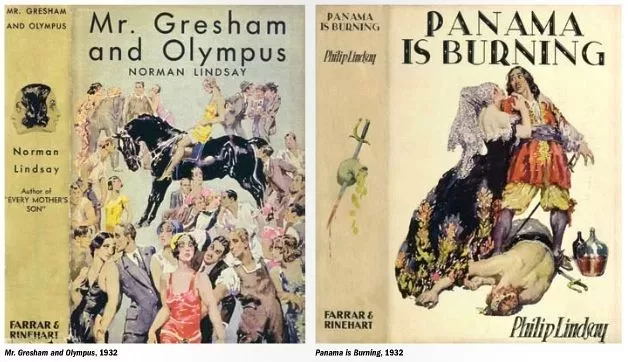

Another great watercolour graced the dust jacket on his son Philip’s novel, Panama is Burning (1932). All of these published appearances arranged by his new American friend, the “particularly handsome,”— according to Rose — Stanley Rinehart of Farrar and Rinehart.
It was as an illustrator though that Norman found the rate of payment here in America thrilling, declaring that “there was no problem about making a living,” referring to Saul Flaum and Ray Long, editors at Cosmopolitan, paying him the equivalent of £300 for the two illustrations he did for “Senõr Shark” by Wallace Smith in the December 1931 issue.
The title illustration is a splash (two page) wash drawing, and is a very dramatic underwater scene that shows Gaspard, one of the story’s main characters, threatened by sharks.
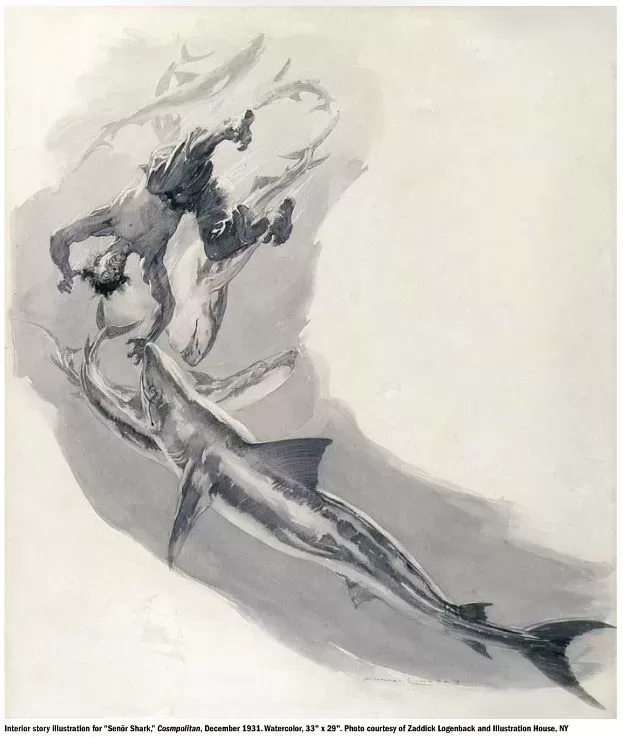

As in Harper’s, Norman was once again keeping good company with the major American illustrators of the day: Flagg, Groesbeck, and others, including, interestingly, Jose Segrelles, the Spanish fantasist who also visited New York.
More than just having their work appear together, Lindsay and Flagg met and got along well enough for Lindsay to sit to have the famous American artist paint his portrait.
Another notable American that Norman greatly admired but did not get to meet was H.L. Mencken. Mencken had been the co-editor of the Smart Set, but it was his The American Mercury (1924-1933) which was loved by Norman for its attacks on pedagogy, Prohibition, and Puritanism — the last something he could certainly relate to.
The admiration was mutual, with Mencken in a letter to a friend dated August 30, 1944, referring to Norman Lindsay as “a remarkable man, with two remarkable sons”.
As a lifelong lover of the theatre it isn’t surprising that while here Norman and Rose would know the actress Blanche Yurka and would stay at her apartment, among other places (like The Whitby Hotel, 325 West 45 Street), who just a couple of years earlier had been featured, along with her photograph, in Redbook (June, 1929), and is well known to film fans as starring in such movies as A Tale of Two Cities, Queen of the Mob, Taxi, and Cry of the Werewolf.
There is a copy of the Fanfrolico Press (headed by NL’s son Jack Lindsay) edition of Lysistrata (1926) in a private collection in NYC today with an original pen and ink showing the heroine of the play speaking with a jazz age flapper by Norman and a gift inscription on the front endpaper to Blanche, presumably as a thank you for her hospitality.
In any event, NL enjoyed New York City, even writing an article, “I Like New York,” which appeared back in Australia (The Home, December 1931). In this article, accompanied by the previously mentioned portrait of him by Flagg, Lindsay relates his admiration for the architecture and the skyline of New York City, noting:
“The New York skyscrapers are so beautifully proportioned to its mass that they look like graceful towers rising from it, and not isolated detachments from it.” Among other observations he goes on to say how, due to “the courtesy I have met with here is so warming I am embarrassed by it,” and concluding “Yes, I like New York. And I more than like Americans.”
Norman Lindsay
Another ‘first’, marking the career of Lindsay, this time here in America, took place February 7, 1931, at the Roerich Museum in New York. The event was the First Contemporary All-Australian Art Exhibition sponsored by the International Art Center of the Roerich Museum, which attracted much attention in the media of the day being reviewed in the New York Times and The Art Digest, among other news journals.
The exhibition was comprised of 92 works of art by 68 artists, many of whom were represented by just a single work. Norman was one of just a few represented by two.
It was there that the first sale was Norman Lindsay’s etching Enter the Magicians, the etching that Lindsay considered his very best, which sold for $100 “within two minutes of the opening of the doors.”
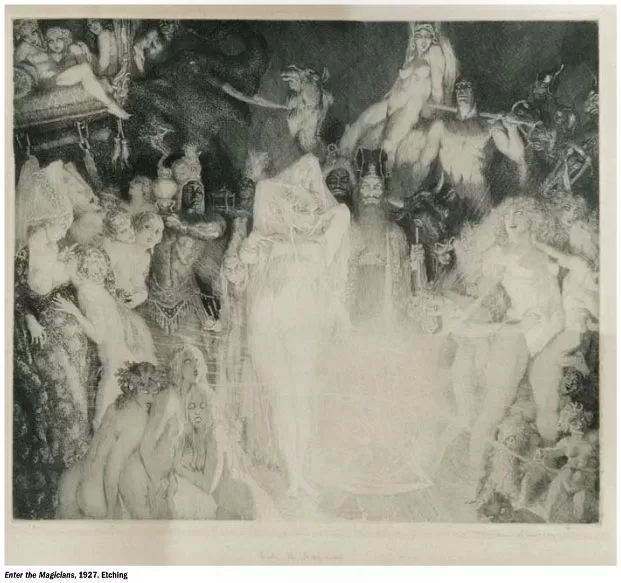

A very brief review, more of a mention really, of this exhibition appeared February 9, 1931 in the Sydney Morning Herald ending with the statement, “Only now and then does an Australian artist succeed in nourishing our imagination.”
It seems more than possible that this may have been referring to Lindsay’s two pieces, as opposed to the majority of the pieces representing his peers consisting primarily of landscapes and still lifes.
Interesting for a couple of reasons was Lindsay manifesting himself as a critic while here. He was able to place the same article “Literature in Australia,” not his first foray into essay writing, in both the Saturday Review of Literature and Fortune magazine.
In it he discusses at length the importance of art and literature to a country and extols the qualities found in the writings of his fellow Australians, Henry Lawson and Louis Stone, and the poetry of Hugh McRae.
Fortune magazine also ran a reproduction of NL’s watercolour “The Dear Things” with a caption lauding Lindsay as “Australia’s provocative genius.”
Despite the recognition he received here by both publishers and literary and artistic circles, in both his letters and in his autobiography My Mask, he makes it clear that he was on a mission to find a publisher willing to embark on an ambitious schedule of seeing Australian authors and poets into print (to avoid a 35% duty recently imposed on the import of books), and a publisher to handle a major volume of his pen and inks, and he would leave America if unsuccessful in this effort.
One such publisher that he entered into talks with about his pen and inks was Walter Chrysler, an encounter he described in a letter to Brian Penton (one of Jack Lindsay’s partners at Fanfrolico Press in London) about January ’32:
“I have also arranged for the publication of my big pen-and-inks with a deluxe firm, Cheshire House, run by young Walter Chrysler, son of old millionaire Chrysler … But I don’t like either his methods of reproduction or his terms, which are to spend all the possible proceeds on the production of the book and leave no profits.”
Norman Lindsay
If one examines a Chrysler production like his The Georgics of Virgil, having been released in New York that very year (1931), making it more than likely that it’s a book Chrysler would have handed Lindsay to show off what Cheshire House was doing, it is possible to comment upon both production values and Lindsay’s concern over profits.
It’s designed by Richard Ellie and limited to 1200 numbered copies, tall folio, well printed on quality paper, bound in boards with a leather spine, and illustrated with twenty full page engravings from the first folio edition.
It is not unlike a Fanfrolico production and Lindsay’s concern over his work being poorly presented seems unfounded.
However, Cheshire House was short lived with only a couple of major titles to its credit, so apparently Norman’s worry over an inadequate profit margin was justified.
So, that was just one of the disappointments that led to his conclusion that his search to find a major American publishing firm willing to commit to publishing Lindsay’s volume of pen and inks, and equally important to him the work of his fellow Australian writers and poets, to be a futile one.
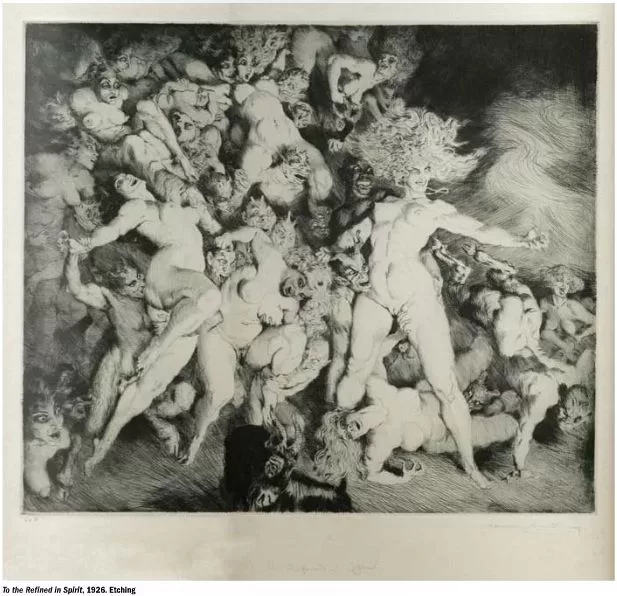

Having failed to realize his main objectives here in the U.S., Lindsay travelled on to England in January 1932.
By March, he despaired of finding a publisher there too, partly due to a tariff problem, plus he hated the climate, so he booked passage on the Mongolia and returned home to Australia.
This story continues here: US art collectors love Norman Lindsay
— © Louis Irmo, 2009 originally published in Illustration magazine issue number 27, Summer edition 2009, republished with permission.
This article is dedicated to Ian Kelf, great guy, the ultimate Lindsay collector, and wonderful friend.
ACKNOWLEDGEMENTS
Helen Glad and the Lindsay Estate. Photographs (Merriam Collection) courtesy of the Print Department of the Boston Public Library. Robert Holden, and his invaluable research. Wm. Hallam Webber for his generous sharing and assistance. Finally, I must thank Karen Shafts, Jane Bloomfield, Tom Mathieson, Barry Klugerman, Randy Broecker, John Dowling, and my wife Susan, my muse and collaborator.
SOURCES
- My Mask, Norman Lindsay, Angus and Robertson, 1970
- The Scribblings of an Idle Mind, Norman Lindsay, Lansdowne Press, 1966
- Model Life, Rose Lindsay, Lin Bloomfield, Odana, 2001
- Portrait of Pa, Jane Lindsay, Odana, 2007
- The World of Norman Lindsay, ed. Lin Bloomfield, MacMillan, 1979
- The Letters of Norman Lindsay, ed. Howarth and Barker, Angus and Robertson, 1979
- The Embattled Olympian, John Hetherington, Oxford University Press, 1973
- The Complete Etchings of Norman Lindsay, ed. Lin Bloomfield, Odana Eds, 1998
- Norman Lindsay Oil Paintings 1889-1969, ed. Lin Bloomfield, Odana Editions, 2008
- The letters of Roy Krenkel—Sedon Thompson (Wm. Hallam Webber collection)

